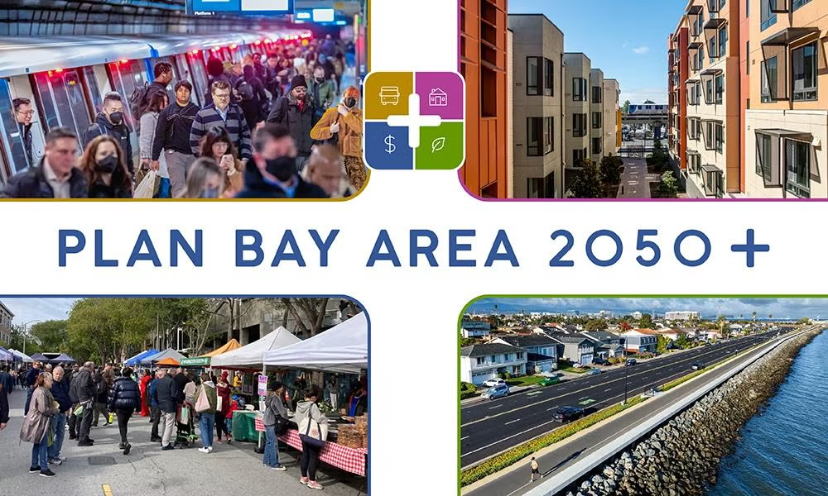MTC, ABAG release draft of new long-range plan for Bay Area
Wednesday, October 22nd, 2025
Public comment through Dec. 18 on Draft Plan Bay Area 2050+, EIR for housing, transportation, economic development and the environment
East Bay Webinar Nov. 5
By Veronica Cummings, Principal Public Information Officer, Engagement & John Goodwin, Assistant Director of Communications, Metropolitan Transportation Commission
After more than two years of public discussion, technical analyses and refinement, the Metropolitan Transportation Commission (MTC) and the Association of Bay Area Governments (ABAG) today released Draft Plan Bay Area 2050+ and the Plan Bay Area 2050+ Draft Environmental Impact Report for public review and comment.
Draft Plan Bay Area 2050+ charts a course for the future of the Bay Area over the next 25 years. Designed to guide growth and investment across the region’s nine counties and 101 cities, the latest plan aims to advance an integrated vision for a Bay Area that is affordable, connected, diverse, healthy and vibrant for all. The plan contains 35 strategies for public policies and investments that can be implemented to help the Bay Area build more homes, reduce commute times, and create vibrant downtowns and natural areas for everyone to enjoy. These strategies also aim to keep people safe from natural hazards, support a strong economy and provide stable housing.
Unique to this plan cycle is Transit 2050+, a parallel and first-of-its-kind planning effort conducted by MTC and ABAG in partnership with Bay Area transit agencies to re-envision the future of Bay Area public transit.

MTC and ABAG have scheduled a series of webinars and public hearings for comment on Draft Plan Bay Area 2050+ and associated supplemental reports, as well as on the Draft Environmental Impact Report for Plan Bay Area 2050+. All interested people, agencies and other organizations are encouraged to attend a webinar or public hearing, where they can ask questions and offer comments on these documents. Full event details are listed below:
- Webinar #1 — North Bay
Wednesday, October 29, 2025
12-1:30 p.m.
Zoom link: https://bit.ly/northbaywebinar - Webinar ID: 892 3077 8001
- Passcode: 256814
- 888-788-0099 US Toll Free
- Webinar #2 — West Bay
Wednesday, October 29, 2025
6-7:30 p.m.
Zoom link: https://bit.ly/westbaywebinar
Webinar ID: 831 4140 5598
Passcode: 096944
888-788-0099 US Toll Free - Webinar #3 — South Bay
Thursday, October 30, 2025
6-7:30 p.m.
Zoom link: https://bit.ly/southbaywebinar
Webinar ID: 822 2561 7467
Passcode: 356845
888-788-0099 US Toll Free - Webinar #4 — East Bay
Wednesday, November 5, 2025
6-7:30 p.m.
Zoom link: https://bit.ly/eastbaywebinar
Webinar ID: 869 8283 4999
Passcode: 682098
888-788-0099 US Toll Free
In addition to these webinars, MTC and ABAG will host three public hearings around the Bay Area to provide opportunities for all interested agencies, organizations and individuals to comment on the Draft Plan and Draft Environmental Impact Report. The full list of hearings is as follows:
- Public Hearing #1 — MTC Planning Committee and ABAG Administrative Committee
Friday, November 14, 2025, at 9:40 a.m. or upon the conclusion of the Bay Area Infrastructure Financing Authority Network and Operations Committee, whichever is later.
Bay Area Metro Center -or- Zoom
Boardroom, 1st Floor
375 Beale Street, San Francisco - Instructions to join by Zoom
- Public Hearing #2 — Fremont
Wednesday, December 3, 2025, at 6 p.m.
Olive Hyde Art Center and Gallery -or- Zoom
123 Washington Boulevard, Fremont
Zoom link: https://bit.ly/drafthearing2
Webinar ID: 875 7625 3306
Passcode: 178983
888 788 0099 US Toll Free - Public Hearing #3 — Novato
Thursday, December 4, 2025, at 6 p.m.
Best Western Plus Novato Oaks Inn -or- Zoom
215 Alameda del Prado, Novato
Zoom link: https://bit.ly/drafthearing3
Webinar ID: 898 0347 9624 - Passcode: 129009
- 888 788 0099 US Toll Free
Interested Bay Area residents, agencies and organizations also are encouraged to view and comment on the draft plan online at planbayarea.org/draftplan. Comments will be reviewed by officials from both ABAG and MTC as they consider the adoption of Final Plan Bay Area 2050+, slated for early 2026.
Written comments will be accepted via mail to MTC Public Information Office, Attn: Plan Bay Area -or- Draft EIR Comments, 375 Beale Street, Suite 800, San Francisco, CA, 94105; or via email (Draft Plan Bay Area 2050+ inbox: info@planbayarea.org; Draft EIR inbox: eircomments@bayareametro.gov). Comments by phone can made at (415) 778-2292.
The comment period for all documents will close Dec. 18, 2025, at 5 p.m.
Questions? Visit planbayarea.org, email info@planbayarea.org or call (415) 778-6757.
Accessible Meetings
Do you need an interpreter or any other assistance to participate? Please call (415) 778-6757. For TDD or hearing impaired, call 711, California Relay Service, or (800) 735-2929 (TTY), (800) 735-2922 (voice) and ask to be relayed to (415) 778-6700. We require at least three working days’ notice to accommodate requests.
¿Necesita un intérprete u otra asistencia para participar? Por favor llámenos con tres días de anticipación al (415) 778-6757. Para telecomunicaciones para personas sordas y discapacitadas, favor de llamar al 711, el Servicio de Retransmisión de California (CRS) para TTY/VCO/HCO a Voz o para Voz a TTY/VCO/HCO al (800) 855-3000 y pedir que lo retrasmitan al (415) 778-6700.
您是否需要口譯或任何其他協助才能參加?請致電(415)778-6757。若需使用TDD或為聽障人士人士,請致電711,加州轉接服務,或(800)735-2929(TTY),(800)735-2922(語音),然後要求轉接至(415)778-6700。請至少提前三個工作日提出申請,以便我們能為您提供適當的口譯安排。
ABAG is the council of governments and the regional planning agency for the 101 cities and towns, and nine counties of the Bay Area. MTC is the transportation planning, financing and coordinating agency for the nine-county San Francisco Bay Area.





































